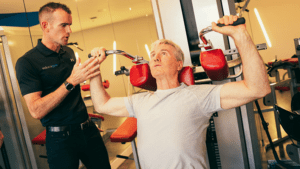A recent survey reveals that one of the top reasons for stress in women in Ireland is their health (Source: RSVP). Half of the women think that they are not in good health and need to improve their physical and mental health.
Women are prone to severe problems as they pass through different stages of their lives, as they age. Research studies have demonstrated that a regular, moderate to intensive strength training program offers substantial health benefits to women. From our previous blog, you’ll now understand that strength training doesn’t make women look bulky (often a woman’s greatest fear!), but instead makes them healthy from inside.
Let’s look at some more health advantages in this blog.
Keep Fit During Pregnancy
When it comes to workouts in pregnancy, there is a lot of debate with regards to safety. The Experts overrule the old-age-myth that exercise or weights can hurt the baby. Studies have demonstrated that consistent training can contribute to the physical and psychological health of pregnant women (Reference: Source 1).
A recent study indicated that supervised, low-to-moderate intensity weight training program is safe and highly beneficial to pregnant women, who do not have any complications. The risk of preeclampsia is reduced by 35%, and there were no musculoskeletal injuries. In fact, an improvement in the endurance of the lumbar extensor muscle group is observed (the muscles in the back used for standing and lifting objects), during strength training (Reference: Source 2).
Many other studies have suggested that muscle strengthening exercises during pregnancy are effective in increasing energy and reducing fatigue (Reference: Source 3).
Prevent Breast Cancer
Breast cancer is a common health problem among women. The risk of breast cancer increases with age. Even though the causes of Breast cancer are not fully recognised, Experts consider multiple factors including reproductive, endocrine factors, hormonal history, use of hormone therapy and other factors such as exposure to ionizing radiation, consumption of alcohol, high-calorie diets, physical inactivity, and obesity (Reference: Source 4).
A new study from the University of Sydney suggests that strength exercises can reduce the risk of all-cause and cancer-related death. Carol Harrison, the senior exercise physiologist at MD Anderson, says strength training offers enormous benefits to prevent Cancer.
Fight Breast Cancer
1 in 9 women develop breast cancer in their lifetime. 49% of them are diagnosed between 45-65 years (Source: Breast Cancer Ireland). Sadly, Breast Cancer survivors go through muscle imbalances, loss of flexibility, and decreased quality of life.
It is found that Resistance Training can lighten these effects, and can even boost the capability to return to pre-treatment activity levels, in both survivors and those undergoing treatment (Source: Reference 5).
The usual concern for Breast Cancer survivors is an increase in body weight, where above 10% is associated with increased mortality risk. Resistance training can improve muscular function and body composition in patients (Source: Reference 6).
While there is plenty of evidence that Resistance or Weight Training offers many health benefits for women. We must always remember that choosing the training type is just one piece of the puzzle. These health conditions are complicated and require supervised training sessions with a personalised training plan. Therefore, finding a good fitness center is equally important.
Hope you like this blog. If you did, please do share it with your friends and family.
References:
1. Effectiveness of Physical Activity Interventions on Pregnancy-Related Outcomes among Pregnant Women: A Systematic Review. Carmen W. H. Chan, Elce Au Yeung, and Bernard M. H. Law. Int J Environ Res Public Health. 2019 May; 16(10): 1840. Published online 2019 May 23. doi: 10.3390/ijerph16101840. PMCID: PMC6571580
2. Safety and Efficacy of Supervised Strength Training Adopted in Pregnancy.Patrick J. O’Connor, Melanie S. Poudevigne, M. Elaine Cress, Robert W. Motl, James F. Clapp, III. J Phys Act Health. Author manuscript; available in PMC 2014 Oct 20. Published in final edited form as: J Phys Act Health. 2011 Mar; 8(3): 309–320. PMCID: PMC4203346.
3. Muscle strengthening exercises during pregnancy are associated with increased energy and reduced fatigue.Christie Ward-Ritacco, Melanie S. Poudevigne, Patrick J. O’Connor. J Psychosom Obstet Gynaecol. Author manuscript; available in PMC 2017 Jan 1. Published in final edited form as: J Psychosom Obstet Gynaecol. 2016; 37(2): 68–72. doi:10.3109/0167482X.2016.1155552. PMCID: PMC4978349
4.Chronic Effects of Resistance Training in Breast Cancer Survivors.Wanderson Divino Nilo dos Santos, Paulo Gentil, Rafael Felipe de Moraes, João Batista Ferreira Júnior, Mário Hebling Campos, Claudio Andre Barbosa de Lira, Ruffo Freitas Júnior, Martim Bottaro, Carlos Alexandre Vieira Biomed Res Int. 2017; 2017: 8367803. Published online 2017 Aug 1. doi: 10.1155/2017/8367803. PMCID: PMC5557266
5. Resistance Training for Breast Cancer Survivors.Lite, Randi S MA, RCEP1; Mejia, Stephanie CSCS2. Strength and Conditioning Journal: October 2010 – Volume 32 – Issue 5 – p 60-62. doi: 10.1519/SSC.0b013e3181d80c00.
6. Impact of resistance training in cancer survivors: a meta-analysis. Strasser B1, Steindorf K, Wiskemann J, Ulrich CM.







